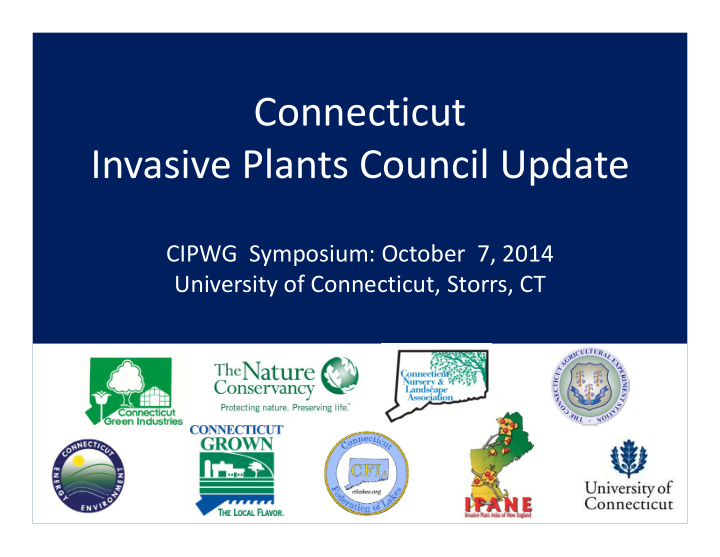



Connecticut Invasive Plants Council Update CIPWG Symposium: October 7, 2014 University of Connecticut, Storrs, CT
Connecticut Invasive Plants Council Connecticut Federation of UConn College The Nature of Agriculture Lakes Conservancy and Natural Resources Agricultural Invasive Plant Experiment Atlas of New Station England Nursery Agriculture Producers Invasive Energy and Green Plants Environment Industry al Protection Trade Council Legend State Agencies Non ‐ governmental Orgs. Academia Industry
IPC Responsibilities – Recommendations to control invasive plants – Publish and update list of invasive & potentially invasive plants – Educate the public and assist state agencies in conducting research – Make recommendations to the General Assembly
Taking Action: Bamboo • Many site visits, discussions with other states • Helped draft legislation that became PA 13 ‐ 82 • Continue to investigate bamboo sites that might qualify as invasive as per State Statute (22a ‐ 381b)
Taking Action: Workshops & Education • Held workshop on new bamboo laws for municipal officials • Conducted four training sessions for 200+ DOT staff • Responded to a growing number of public inquiries
Taking Action: Science & Prevention • Investigated legal status cultivars of CT prohibited species • Developed BMPs for giant cane ( Arundo donax ) in biofuel industry. Now being reviewed by EPA and USDA
Success: • Helped inform Environment Committee of damage from Aquatic Invasive Species (AIS) • $200,000 in FY 15 budget • $150K made available as grants to municipalities Milfoil Water Chestnut
What’s next? Continue to move the needle! (A) Prevention = Outreach & Education (B) Ongoing assessment of running bamboo (C) Find a broadly accepted solution to the cultivar issue (D) **Secure funding for the Invasive Plant Coordinator ($90,000 per year for entire program!)**
Big Picture: Approach to Prevention MOU between States, Pet Trade, USFWS • Signed in 2013 • To reduce the risk posed by potentially invasive species not currently in trade. Aquatic species only • Collectively select potential invaders … USFWS scientists do screening … States review … Science driven process ! … Pet Trade implement voluntarily restrictions & evaluate If this non ‐ regulatory approach is successful it should be expanded to other industries and other scales
Big Picture: Congressional Invasive Species Caucus Established in 2012 Only 22 members, none from CT Platform for discussion of invasive species issues at Federal Level Grassroots effort to “ Grow the Caucus ” underway by AFWA and NGOs Simple request to our representatives in Congress: “ Join the Caucus ” Foundational effort!
In the final analysis, there will never be enough funding or enough enforcement to solve the invasive species problem. The only practical solution is … Thank you!
Recommend
More recommend